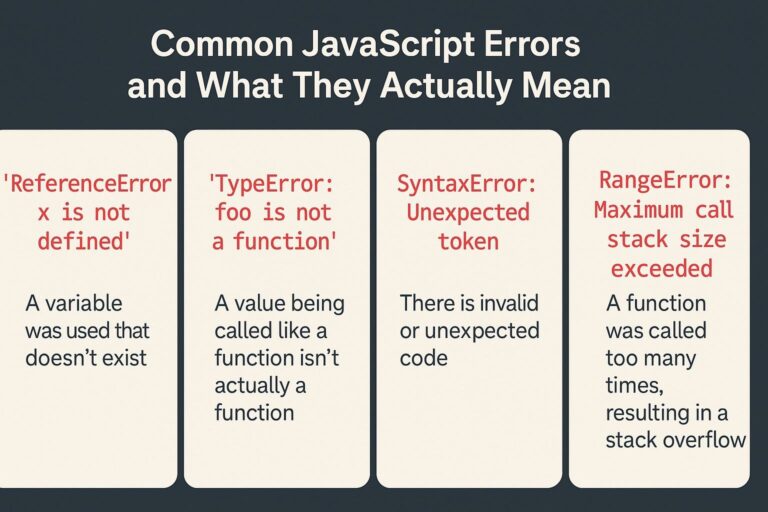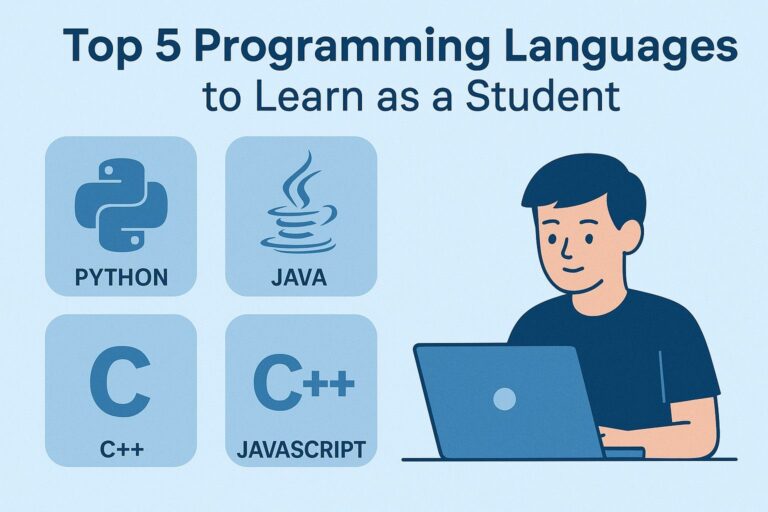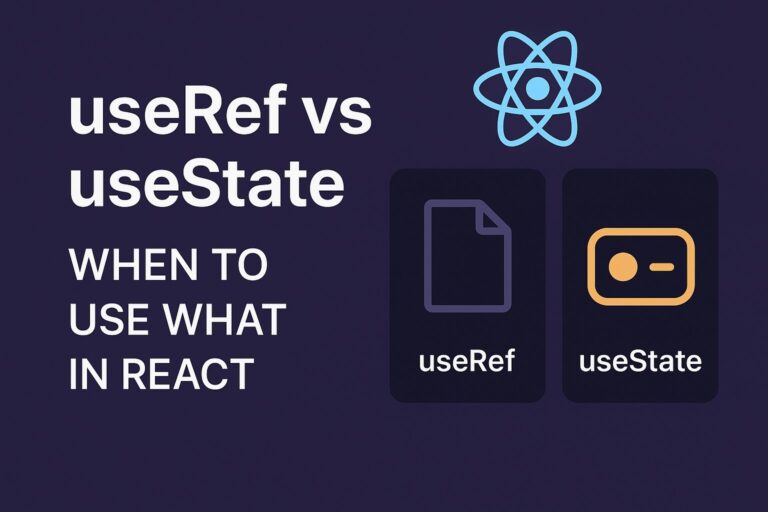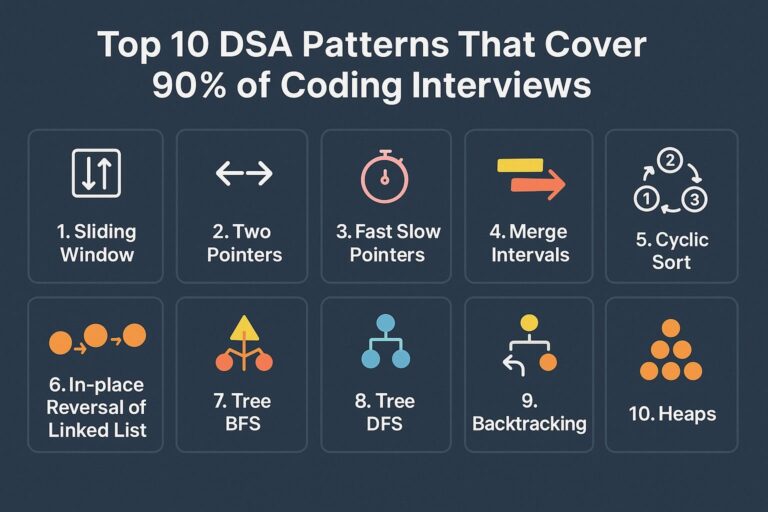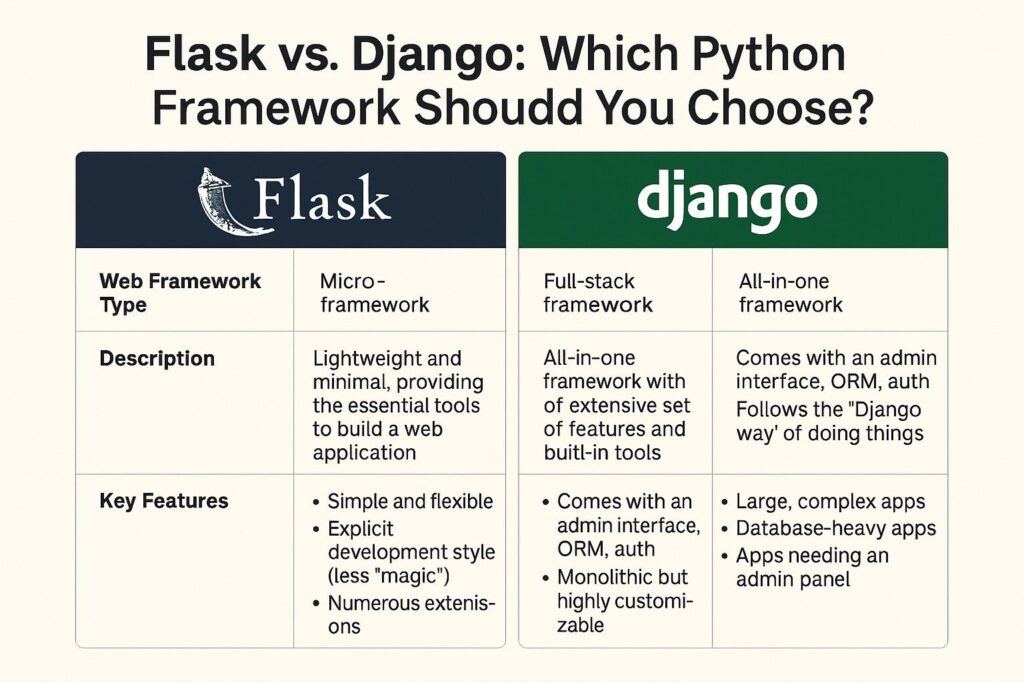
When it comes to building powerful, scalable, and maintainable web applications in Python, two frameworks dominate the landscape: Flask and Django. Each has its strengths, and the right choice depends on your project requirements, team size, and experience level.
In this comprehensive comparison, we’ll walk through what makes Flask and Django unique, highlight their core differences, and guide you toward making an informed decision.
What is Django?
Django is a full-stack, high-level Python web framework designed for rapid development and clean, pragmatic design. It follows the Model-View-Template (MVT) architecture and emphasizes convention over configuration. Built with scalability and security in mind, Django is ideal for projects that need built-in tools, robust authentication systems, and a structured environment.
Core Features of Django:
- Built-in ORM: Connects Python classes to relational databases seamlessly.
- Admin Interface: Auto-generates admin dashboards for data management.
- User Authentication: Complete system for login, registration, and password management.
- Form Handling: Robust form system for validation and rendering.
- CSRF Protection: Cross-site request forgery protection is built-in by default.
- Template Engine: Clean separation of logic and presentation.
- URL Routing: Clean URL dispatcher with regular expressions or path converters.
Django’s ecosystem includes tools like Django REST Framework (DRF) for API development and Celery for task queues, making it suitable for complex applications with a wide range of features.
What is Flask?
Flask is a micro web framework designed to be simple and unopinionated. It gives developers full control over the application architecture by keeping the core minimal and extensible. Unlike Django, Flask doesn’t ship with built-in features such as an ORM or form validation—but you can add these via third-party libraries.
Core Features of Flask:
- Minimal Core: Gives flexibility to structure your app as needed.
- Jinja2 Templating: Clean and expressive templating system.
- Routing via Decorators: Simple and explicit URL-to-view mapping.
- Extensible: Use only the tools you need (e.g., SQLAlchemy, Flask-WTF, Flask-Login).
- Built-in Development Server and Debugger
Flask is often chosen for microservices, RESTful APIs, and prototypes, where lightweight and speed of development are priorities.
Key Differences Between Flask and Django
| Feature | Django | Flask |
|---|---|---|
| Framework Type | Full-stack | Micro-framework |
| Philosophy | Convention over configuration | Explicit over implicit |
| Project Structure | Predefined | Developer-defined |
| Admin Panel | Built-in | Third-party (e.g., Flask-Admin) |
| ORM | Django ORM (built-in) | No built-in ORM; uses SQLAlchemy or others |
| Authentication | Built-in | Flask-Login or custom |
| Form Handling | Built-in | Flask-WTF (optional) |
| Scalability | Suitable for monoliths and large-scale apps | Excellent for microservices and modular apps |
| Learning Curve | Steep but well-documented | Gentle for beginners |
| Flexibility | Less flexible but consistent | Highly flexible and customizable |
| Best Suited For | Enterprise apps, CMS, e-commerce | APIs, MVPs, lightweight tools |
| Community Size | Larger, older | Active but smaller |
| Third-party Ecosystem | Mature, official plugins | Decentralized, but diverse extensions |
| Deployment | Well-supported on Heroku, AWS, Docker | Easy to containerize and deploy via WSGI |
When Should You Use Django?
1. You’re Building a Feature-Rich Application
If your application requires user accounts, admin dashboards, form submissions, database interactions, and more—Django gives you everything in one package.
2. You Want a Predictable, Scalable Architecture
Django promotes a clear separation of concerns with its MVT architecture. This is extremely beneficial for large teams working on big projects.
3. You Need Built-In Security
Django includes protection against common vulnerabilities like XSS, CSRF, SQL injection, and clickjacking by default.
4. You Want Rapid Development
The admin interface and prebuilt components allow for fast iterations—perfect for startups looking to launch products quickly.
5. You’re Building a CMS, Marketplace, or Blog
Django’s structured components and integrated ORM make it ideal for content-heavy applications with complex data models.
Popular Websites Using Django:
- Mozilla
- Pinterest (early stages)
- National Geographic
- Disqus
When Should You Use Flask?
1. You Want Maximum Flexibility
Flask doesn’t impose any design patterns, so you can architect your application any way you like—monolith, microservice, layered, or modular.
2. You’re Building APIs or Microservices
Flask is particularly strong for API-only backends. Combine it with tools like Flask-RESTful, Marshmallow, or Connexion for robust APIs.
3. You’re Prototyping or Building an MVP
Flask’s minimal setup lets you go from idea to prototype in hours, making it great for experimentation.
4. You’re Integrating with a Non-Traditional Backend
Flask gives you full control of the request/response cycle, ideal for apps that require specialized communication (e.g., sockets, event-driven systems).
Popular Tools and Services Built with Flask:
- Netflix (internal systems)
- Lyft
- Reddit (parts of it)
- Airbnb (Apache Airflow)
Performance and Deployment
While both frameworks are fast, Flask may have an edge in raw performance for minimal apps, thanks to its lightweight core. However, Django’s performance is well-optimized for its size and is more than sufficient for most web applications.
Deployment Considerations:
- Use Gunicorn or uWSGI as a production WSGI server
- Place behind a reverse proxy like Nginx
- Use Docker for containerized environments
- For scalability, integrate Redis, Celery, or NGINX Load Balancing
Ecosystem and Tooling
| Tooling Area | Django | Flask |
|---|---|---|
| Authentication | Built-in | Flask-Login, Flask-Security |
| Admin Interface | Built-in | Flask-Admin |
| Database Support | Django ORM | SQLAlchemy, Peewee |
| Forms | Django Forms | Flask-WTF |
| API Tools | Django REST Framework | Flask-RESTful, Flask-API |
| Task Queues | Celery | Celery or RQ |
| Testing Tools | Django’s TestCase class | unittest, pytest |
| Static Files | Built-in staticfiles app | Manually configured |
| Internationalization | Built-in i18n support | Flask-Babel extension |
Learning Curve and Documentation
- Django has comprehensive official documentation and is supported by many tutorials and books.
- Flask’s documentation is simple and to-the-point, ideal for newcomers.
Django can feel overwhelming to beginners due to its breadth, but its built-in tooling reduces decision fatigue. Flask is more approachable initially but requires decisions about architecture, extensions, and configuration as your app grows.
Final Comparison: Which One Should You Use?
| Scenario | Best Choice |
|---|---|
| Full-stack web application | Django |
| Admin panel, forms, and user management | Django |
| REST API or backend for SPAs | Flask |
| Learning web development as a beginner | Flask |
| Prototyping or MVP | Flask |
| Enterprise-level CMS or marketplace | Django |
| Custom workflows or real-time apps | Flask |
| Data science dashboards | Flask |
Final Thoughts
Both Django and Flask are excellent choices—there is no “one-size-fits-all” answer. Your decision should depend on your project scope, team structure, timeline, and preferred development style.
- Choose Django if you need a full-featured, production-ready solution with built-in components.
- Choose Flask if you want flexibility, minimalism, or are building an API-driven service.
Whichever you choose, both frameworks are robust, actively maintained, and backed by vibrant developer communities. By mastering either one, you position yourself well in the Python web development landscape.

I’m Shreyash Mhashilkar, an IT professional who loves building user-friendly, scalable digital solutions. Outside of coding, I enjoy researching new places, learning about different cultures, and exploring how technology shapes the way we live and travel. I share my experiences and discoveries to help others explore new places, cultures, and ideas with curiosity and enthusiasm.

